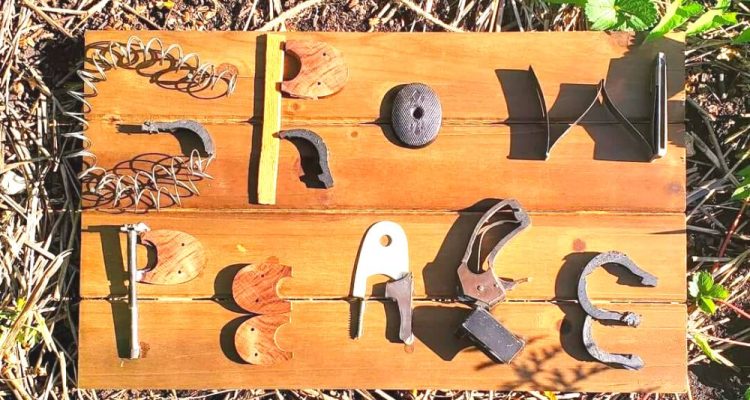Frank Jonas, a firearms dealer for Remington once said, “We certainly are in a hell of a business…A fellow has to wish for trouble so as to make a living, the only consolation being, however, if we don’t get in the business, someone else will…It would be a terrible state of affairs if my conscience started to bother me now. (emphasis added)”
Mike McIntire of The New York Times recently reported that “The Guns were said to be destroyed, instead, they were reborn.” They were made new. They were dismantled and deconstructed so they could be put back together again. There is a company, Gunbusters, that contracts with numerous police departments to destroy their confiscated and turned in firearms. But only kind of.

Split Cross by Scotty Utz
Part of the problem with regulating firearms is the multiple styles of firearms: from handguns to rifles to shotguns, and more. But it’s also the components they are made of. The Gun Control Act of 1968 defines a firearm as the receiver or frame of the firearm. Its what receives the serial number and what everything else connects to – trigger, stock, barrel, and other mechanisms that when all combined, create what many of us would visually recognize as a gun.
What Gunbusters does, and to their credit, don’t try to hide it, is disassemble all the pieces and parts, and only destroy the receiver or frame, the part with the serial number on it. The rest of the pieces are sold as a kit. They destroy firearms for free because they can sell the parts to make money. So popular they are, as McIntire reports, that the most popular online site to sell firearms, GunBroker, has frames and receivers for sale referencing which of GunBusters kits can be paired with it to make a functioning firearm.

Xylophone by youth in Albuquerque
Some of those frames and receivers can be bought without a serial number because they follow the 80% rule. If a frame or receiver is under 80% complete, it doesn’t need a serial number. So toolkits are made to sell a receiver that isn’t fully complete, but can be made complete by a buyer, then paired with a gun kit like those that Gunbusters sells, and be born again.
McIntire tapped into some theological language many of us are familiar with. In fact, the gun industry does this, too. Advertisements that tap into fear and moral superiority that justify pulling a trigger in almost any instance.
J. Warren Cassidy, a former NRA Executive, once said “we should approach the NRA as one of the world’s great religions.” I’d expand that to the gun industry and the culture it has created.
In McIntire’s article and subsequent segment on NYT’s The Daily, The afterlife of a Gun, has put a stir among municipalities and nonprofits, especially faith communities, who have hosted gun buybacks in partnership with police and have since found out the firearms turned in at their events, were “processed” by GunBusters.

Garden tools and cooking tools made from guns arranged in a peace sign.
All of this is so transactional. Like a “get out of hell” free card.
But there are folks doing this in a more transformative way. RAWtools and their partners have been destroying guns for free. Except we’re not taking them apart and reselling their parts a-la-carte. We’re making the cuts through the firearm with everything intact. We’re not just cutting through the receiver and frame, we’re cutting through the trigger assembly, barrel threads, stocks, springs, and other moving parts. The plastic and soft metal of modern firearms are melting as the cuts are made. The steel of old rifles and shotguns is glowing orange and red as it is destroyed. They are not dismantled, but wholly destroyed as a firearm. And in many cases, folks who have been directly impacted by gun violence, who have lost loved ones, are the ones helping destroy the firearms. It’s an opportunity, as so many of them tell us, “to physically do something with my hands to make a difference.” “It’s the healthiest thing I’ve done with the anger of my grief in 30 years,” another told us.
And yet, the destroyed pieces remain. These are what is transformed. Not back into guns, but into a plowshare, or jewelry, or piece of art that begs us to live into another way. Those affected by gun violence participate in this, too. Those affected by the mass trauma of mass shootings are learning how to blacksmith. Retired and bi-vocational clergy who feel need to practice what they’ve preached.
Many of them took part in a forging marathon in June of 2023, laboring one minute for every life lost to gun violence in 2022 – over 44,000. In all, 50,000 minutes were logged by dozens of makers. Much of what they have made is on display at the Colorado Springs Fine Art Center in an exhibit, “Another Way is Possible.” Select items from the exhibit are available through auction to support this growing national movement of turning guns into garden tools.

Hawks can become doves.
But its more than the tangible transformation of a sword into a plowshare. It’s also our participation in that process. To not just heal the elements that make a gun, but to heal our hearts from the trauma we have experienced and the trauma we have caused. Not to create a machine that does this for us, but to accept the invitation to help destroy a firearm or pick up a hammer that beats on the metal from a gun on its way to a plowshare. Because we need to transfer the energy of our pain into a process that transforms that energy into life.
This is how we are reborn. Another way is possible.

